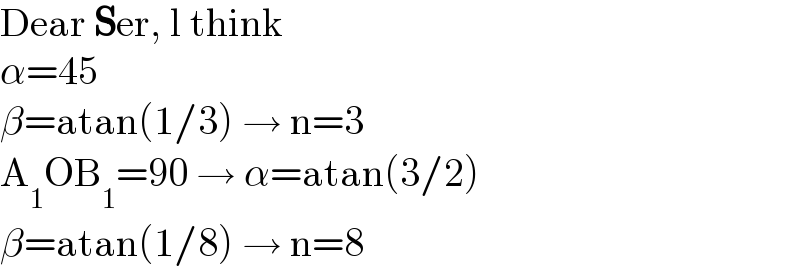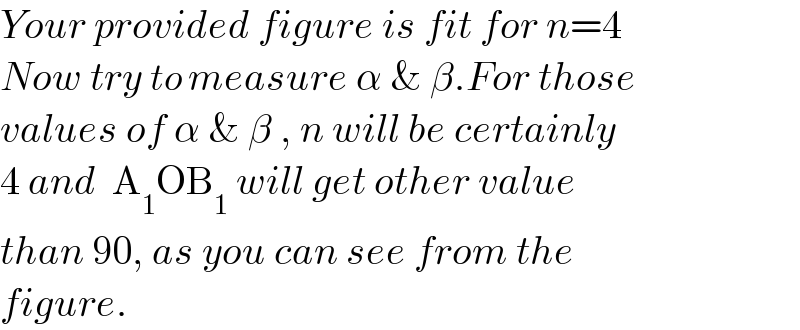Question Number 154204 by mathdanisur last updated on 15/Sep/21

Commented by Rasheed.Sindhi last updated on 16/Sep/21

$$\boldsymbol{\mathrm{Sorry}}\:\mathrm{that}\:\mathrm{I}\:\mathrm{neglect}\:“\:\frac{\mathrm{tan}\alpha\:}{\mathrm{tan}\beta\:}\:\in\mathbb{Z}^{+} \:''. \\ $$$$\mathrm{Now}\:\mathrm{the}\:\mathrm{question}\:\mathrm{can}\:\mathrm{be}\:\mathrm{solved}\:\mathrm{for} \\ $$$$\mathrm{some}\:\mathrm{fixed}\:\mathrm{answers}. \\ $$
Answered by Rasheed.Sindhi last updated on 15/Sep/21

$$\:\bullet\bigtriangleup\mathrm{OA}_{\mathrm{1}} \mathrm{C}\:{in}\:{which}\:\angle\mathrm{COA}_{\mathrm{1}} =\alpha+\beta \\ $$$$\:\:\:\frac{\mathrm{sin}\left(\alpha+\beta\right)\:}{\mathrm{2}}=\frac{\mathrm{sin}\angle\mathrm{OCA}_{\mathrm{1}} \:}{\mathrm{1}} \\ $$$$\:\:\:\mathrm{C}=\mathrm{sin}^{−\mathrm{1}} \left(\frac{\mathrm{sin}\left(\alpha+\beta\right)\:}{\mathrm{2}}\right) \\ $$$$\:\:\angle\mathrm{A}_{\mathrm{n}} \mathrm{OB}_{\mathrm{2}} =\alpha+\beta+\mathrm{OCA}_{\mathrm{1}} \\ $$$$\:\:\angle\mathrm{A}_{\mathrm{n}} \mathrm{OB}_{\mathrm{2}} =\alpha+\beta+\mathrm{sin}^{−\mathrm{1}} \left(\frac{\mathrm{sin}\left(\alpha+\beta\right)\:}{\mathrm{2}}\right) \\ $$$$\angle\mathrm{OA}_{\mathrm{1}} \mathrm{C}=\pi−\left(\alpha+\beta+\mathrm{C}\right) \\ $$$$\angle\mathrm{OA}_{\mathrm{1}} \mathrm{C}=\pi−\left(\alpha+\beta+\mathrm{sin}^{−\mathrm{1}} \left(\frac{\mathrm{sin}\left(\alpha+\beta\right)\:}{\mathrm{2}}\right)\right) \\ $$$$\bullet\bigtriangleup\mathrm{OA}_{\mathrm{n}} \mathrm{D}\:{in}\:{which}\:\angle\mathrm{DOA}_{\mathrm{n}} =\beta \\ $$$$\:\:\:\frac{\mathrm{sin}\beta\:}{\mathrm{1}}=\frac{\mathrm{sinD}\:}{\mathrm{n}} \\ $$$$\bullet\bigtriangleup\mathrm{OA}_{\mathrm{1}} \mathrm{E}\:{in}\:{which}\:\angle\mathrm{EOA}_{\mathrm{1}} =\beta \\ $$$$\frac{\mathrm{sin}\beta\:}{\mathrm{A}_{\mathrm{1}} \mathrm{E}}=\frac{\mathrm{sinE}\:}{\mathrm{OA}_{\mathrm{1}} } \\ $$$$\frac{\mathrm{sin}\beta\:}{\mathrm{A}_{\mathrm{1}} \mathrm{E}}=\frac{\mathrm{sinE}\:}{\mathrm{1}} \\ $$$$\bullet\bigtriangleup\mathrm{OA}_{\mathrm{1}} \mathrm{E}\sim\bigtriangleup\mathrm{OA}_{\mathrm{n}} \mathrm{D} \\ $$$$\frac{\mathrm{OA}_{\mathrm{1}} }{\mathrm{OA}_{\mathrm{n}} }=\frac{\mathrm{A}_{\mathrm{1}} \mathrm{E}}{\mathrm{A}_{\mathrm{n}} \mathrm{D}} \\ $$$$\frac{\mathrm{1}}{\mathrm{n}}=\frac{\mathrm{A}_{\mathrm{1}} \mathrm{E}}{\mathrm{1}} \\ $$$$\mathrm{n}=\frac{\mathrm{1}}{\mathrm{A}_{\mathrm{1}} \mathrm{E}} \\ $$$$\:\:\:\:\:\mathrm{Continue} \\ $$
Commented by mathdanisur last updated on 15/Sep/21

$$\boldsymbol{\mathrm{S}}\mathrm{er},\:\mathrm{ans}:\:\mathrm{n}=\mathrm{8}\:\mathrm{and}\:\mathrm{A}_{\mathrm{1}} \mathrm{OB}_{\mathrm{1}} =\mathrm{90}° \\ $$
Commented by Rasheed.Sindhi last updated on 15/Sep/21

$${I}\:{think}\:\:{that}\:{the}\:{answers}\:{depend} \\ $$$${upon}\:{the}\:{values}\:{of}\:\alpha\:\&\:\beta. \\ $$
Commented by mathdanisur last updated on 15/Sep/21

$$\mathrm{Dear}\:\boldsymbol{\mathrm{S}}\mathrm{er},\:\mathrm{l}\:\mathrm{think} \\ $$$$\alpha=\mathrm{45} \\ $$$$\beta=\mathrm{atan}\left(\mathrm{1}/\mathrm{3}\right)\:\rightarrow\:\mathrm{n}=\mathrm{3} \\ $$$$\mathrm{A}_{\mathrm{1}} \mathrm{OB}_{\mathrm{1}} =\mathrm{90}\:\rightarrow\:\alpha=\mathrm{atan}\left(\mathrm{3}/\mathrm{2}\right) \\ $$$$\beta=\mathrm{atan}\left(\mathrm{1}/\mathrm{8}\right)\:\rightarrow\:\mathrm{n}=\mathrm{8} \\ $$
Commented by Rasheed.Sindhi last updated on 15/Sep/21

$$\mathcal{T}{ry}\:{to}\:{set}\:{different}\:{values}\:{for}\:\alpha\:\& \\ $$$$\beta\:{you}'{ll}\:{get}\:{different}\:{values}\:{of} \\ $$$$\mathrm{A}_{\mathrm{1}} \mathrm{OB}_{\mathrm{1}} \:\&\:\mathrm{n}\:\left(\mathrm{although}\:\mathrm{may}\:\mathrm{be}\:\mathrm{not}\right. \\ $$$$\left.\mathrm{whole}\:\mathrm{number}\right) \\ $$$${You}\:{may}\:{draw}\:{such}\:{figure}\:{for}\:{n}=\mathrm{6} \\ $$$${in}\:{that}\:{case}\:\alpha\:\&\:\beta\:{will}\:{change}! \\ $$
Commented by Rasheed.Sindhi last updated on 15/Sep/21

$${Your}\:{provided}\:{figure}\:{is}\:{fit}\:{for}\:{n}=\mathrm{4} \\ $$$${Now}\:{try}\:{to}\:{measure}\:\alpha\:\&\:\beta.{For}\:{those} \\ $$$${values}\:{of}\:\alpha\:\&\:\beta\:,\:{n}\:{will}\:{be}\:{certainly} \\ $$$$\mathrm{4}\:{and}\:\:\mathrm{A}_{\mathrm{1}} \mathrm{OB}_{\mathrm{1}} \:{will}\:{get}\:{other}\:{value}\: \\ $$$${than}\:\mathrm{90},\:{as}\:{you}\:{can}\:{see}\:{from}\:{the} \\ $$$${figure}. \\ $$
Commented by mathdanisur last updated on 15/Sep/21

$$\mathrm{Thank}\:\mathrm{you}\:\boldsymbol{\mathrm{S}}\mathrm{er}\:\mathrm{for}\:\mathrm{solution} \\ $$
Commented by Rasheed.Sindhi last updated on 15/Sep/21

$$\mathcal{BTW}\:\:{what}'{s}\:{your}\:{source}\:{of}\:{your} \\ $$$${questions}\:{ser}? \\ $$
Commented by mathdanisur last updated on 15/Sep/21

$$\mathrm{From}\:\mathrm{the}\:\mathrm{school}\:\mathrm{l}\:\mathrm{went}\:\mathrm{to}\:\mathrm{Ser} \\ $$
Commented by mathdanisur last updated on 15/Sep/21

$$\mathrm{and}\:\mathrm{yes}\:\mathrm{Ser}\:\:\mathrm{n}=\mathrm{4}\:\:\mathrm{angle}\:\mathrm{60}° \\ $$
Commented by mathdanisur last updated on 15/Sep/21

$$\mathrm{dear}\:\mathrm{Ser},\:\mathrm{can}\:\mathrm{you}\:\mathrm{contunie}?\:\mathrm{please} \\ $$
Commented by Rasheed.Sindhi last updated on 16/Sep/21

$$\mathrm{I}'\mathrm{ll}\:\mathrm{be}\:\mathrm{happy}\:\mathrm{if}\:\mathrm{I}\:\mathrm{can}\:\mathrm{answer}\:\mathrm{any}\:\mathrm{of} \\ $$$$\mathrm{your}\:\mathrm{questions}.\mathrm{But}\:\mathrm{I}'\mathrm{m}\:\mathrm{not}\:\mathrm{an}\:\mathrm{expert}. \\ $$$$\mathrm{I}'\mathrm{m}\:\mathrm{only}\:\boldsymbol{\mathrm{trying}}\:\mathrm{to}\:\mathrm{solve}\:\mathrm{very}\:\mathrm{few}\:\mathrm{questions}. \\ $$$$\mathrm{Anyway}\:\mathrm{don}'\mathrm{t}\:\mathrm{worry}\:\mathrm{there}\:\mathrm{are}\:\mathrm{so} \\ $$$$\mathrm{many}\:\mathrm{experts}\:\mathrm{in}\:\mathrm{the}\:\mathrm{forum}.\mathrm{Of}\:\mathrm{course} \\ $$$$\mathrm{this}\:\mathrm{forum}\:\mathrm{is}\:\mathrm{a}\:\mathrm{good}\:\mathrm{place}\:\mathrm{to}\:\mathrm{learn}… \\ $$$$\mathrm{Again}\:\mathrm{request}\:\mathrm{you}\:\mathrm{to}\:\mathrm{share}\:\mathrm{your} \\ $$$$\mathrm{solutions}\:\mathrm{also}.\:\mathrm{Thanks}\:\mathrm{ser}. \\ $$
Commented by mathdanisur last updated on 16/Sep/21

$$\mathrm{THANK}\:\mathrm{YOU}\:\mathrm{DEAR}\:\boldsymbol{\mathrm{SER}} \\ $$
Answered by Rasheed.Sindhi last updated on 17/Sep/21

$$\mathcal{A}{n}\:\mathcal{E}{asy}\:\mathcal{C}{ase}:\angle{A}_{\mathrm{1}} {O}\:{B}_{\mathrm{1}} =\mathrm{90} \\ $$$$\bigtriangleup{COA}_{\mathrm{1}} ,\bigtriangleup{DOA}_{{n}} \:{are}\:{right}\:{triangles}. \\ $$$$\overset{\bigtriangleup{COA}_{\mathrm{1}} :} {\angle{COA}_{\mathrm{1}} =\alpha+\beta}\:,\:\:\:\:\:\overset{\bigtriangleup{DOA}_{{n}} :} {\angle{DOA}_{{n}} =\beta} \\ $$$$\mathrm{tan}\angle{COA}_{\mathrm{1}} =\mathrm{tan}\left(\alpha+\beta\right)=\frac{\mathrm{2}}{\mathrm{1}} \\ $$$$\alpha+\beta=\mathrm{tan}^{−\mathrm{1}} \left(\mathrm{2}\right) \\ $$$$\mathrm{tan}\angle{DOA}_{{n}} =\:\mathrm{tan}\beta=\frac{\mathrm{1}}{{n}}\Rightarrow\beta=\mathrm{tan}^{−\mathrm{1}} \left(\frac{\mathrm{1}}{{n}}\right)\: \\ $$$$\frac{\mathrm{tan}\alpha\:}{\mathrm{tan}\beta}=\frac{\mathrm{tan}\left(\:\left(\alpha+\beta\right)−\beta\right)}{\mathrm{tan}\beta} \\ $$$$=\frac{\mathrm{tan}\left(\mathrm{tan}^{−\mathrm{1}} \left(\mathrm{2}\right)−\mathrm{tan}^{−\mathrm{1}} \left(\frac{\mathrm{1}}{{n}}\right)\right)}{\mathrm{tan}\left(\mathrm{tan}^{−\mathrm{1}} \left(\frac{\mathrm{1}}{{n}}\right)\right)} \\ $$$$\begin{array}{|c|}{\mathrm{tan}\left({a}−{b}\right)=\frac{\mathrm{tan}\:{a}−\mathrm{tan}\:{b}}{\mathrm{1}+\mathrm{tan}\:{a}.\mathrm{tan}\:{b}}}\\\hline\end{array} \\ $$$$=\frac{\frac{\mathrm{2}−\frac{\mathrm{1}}{{n}}}{\mathrm{1}+\mathrm{2}\left(\frac{\mathrm{1}}{{n}}\right)}}{\frac{\mathrm{1}}{{n}}}=\frac{\frac{\mathrm{2}{n}−\mathrm{1}}{{n}+\mathrm{2}}}{\mathrm{1}/{n}}=\frac{{n}\left(\mathrm{2}{n}−\mathrm{1}\right)}{{n}+\mathrm{2}} \\ $$$$\frac{\mathrm{tan}\alpha\:}{\mathrm{tan}\beta}=\frac{{n}\left(\mathrm{2}{n}−\mathrm{1}\right)}{{n}+\mathrm{2}}\:\in\mathbb{Z}^{+} \Rightarrow{n}=\mathrm{3},\mathrm{8} \\ $$$$\angle{A}_{\mathrm{1}} {O}\:{B}_{\mathrm{1}} =\mathrm{90}\:\begin{cases}{{n}=\mathrm{3}}\\{{n}=\mathrm{8}}\end{cases} \\ $$
Commented by Rasheed.Sindhi last updated on 17/Sep/21

Commented by mathdanisur last updated on 17/Sep/21

$$\mathrm{Very}\:\mathrm{nice}\:\mathrm{thank}\:\mathrm{you}\:\mathrm{alot}\:\mathrm{Ser} \\ $$
